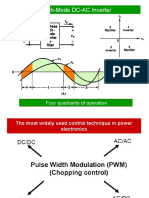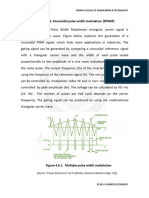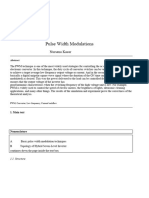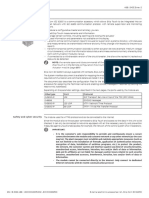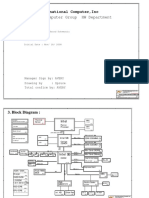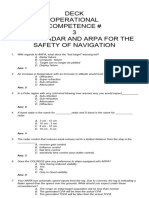Chapter PWM
PWM (Pulse Width Modulation) is a technique used to control the amount of power delivered to
electrical devices, especially in applications such as motor control, LED dimming, and power regulation.
It works by varying the duty cycle (the proportion of "on" time to "off" time) of a digital signal, which
allows for smooth control of power output without significant energy loss.
Key points about PWM:
• Duty Cycle: Expressed as a percentage, it indicates how long the signal is "on" compared to the
total cycle duration.
• Frequency: Refers to how many times per second the signal completes a full cycle (on and off).
Higher frequencies result in smoother control.
• Efficiency: PWM is energy-efficient because the power switch (e.g., transistor) operates fully on
or off, minimizing power dissipation.
PWM is widely used in solar inverters, motor drivers, and other power electronics systems to efficiently
control power output.
The importance of PWM (Pulse Width Modulation) lies in its efficiency and versatility in controlling
electrical devices. Some key reasons why PWM is important include:
1. Energy Efficiency: PWM allows precise control over the power delivered to a load without
generating excessive heat. By switching between full on and full off states, it minimizes energy
losses compared to other methods like resistive control.
2. Speed Control for Motors: PWM is commonly used to regulate the speed of DC motors. By
adjusting the duty cycle, the motor can be run at different speeds without losing torque, making
it efficient for applications like electric vehicles, industrial drives, and fans.
3. Power Regulation: PWM is crucial in power supply units (like inverters) to regulate voltage and
current precisely. In renewable energy systems, such as solar inverters, PWM is used to optimize
power transfer between the solar panels and the grid or batteries.
4. Brightness Control: PWM is used in LED dimming systems, allowing control over light intensity
without sacrificing efficiency or lifespan of the LEDs.
5. Signal Control and Noise Reduction: PWM can reduce electromagnetic interference (EMI) by
operating at high frequencies, making it ideal for use in sensitive electronic applications.
6. Cost-Effective: PWM controllers are simple and cost-effective, making them widely adopted in
numerous consumer electronics and industrial applications.
����� Bipolar PWM is simpler but generates higher voltage ripple, more harmonic distortion, and more
electromagnetic interference.
Unipolar PWM offers lower switching losses, less harmonic distortion, and reduced EMI, making it
more efficient and suitable for modern power conversion applications.
�����Summary:
• Unipolar PWM offers better efficiency and lower harmonic distortion compared to Bipolar PWM.
• It switches between three voltage levels, leading to smoother output.
• The effective switching frequency is twice that of the carrier frequency, which reduces ripple and
improves the quality of the output waveform.
Multiple Choice Questions:
1. What is the modulation index in pulse-width modulation (PWM)? a) Ratio of the carrier
signal's frequency to the reference signal's frequency
b) Ratio of the reference signal's amplitude to the carrier signal's amplitude
c) The frequency of the triangular wave
d) The ratio of output voltage to input voltage
Answer: b
2. What happens if the modulation index M is greater than 1 in sinusoidal PWM? a) Full
modulation without distortion
b) No output waveform
c) Overmodulation leading to waveform distortion
d) The output voltage increases without limit
Answer: c
� 3. For a sinusoidal PWM inverter, the modulation index is the ratio of: a) Carrier wave frequency
to the reference signal amplitude
b) Peak of the reference signal to the peak of the carrier signal
c) Peak of the carrier signal to the DC bus voltage
d) Reference signal frequency to the output voltage
Answer: b
Short Answer Questions:
1. Define the modulation index in PWM and explain its significance.
Expected Answer:
The modulation index M in PWM is the ratio of the peak amplitude of the reference signal to the peak
amplitude of the carrier signal. It determines how much of the available DC bus voltage is utilized. For
M>1, the system enters overmodulation, causing harmonic distortion in the output. For M=1,
maximum utilization of the DC voltage occurs without distortion. For M<1, the output voltage is
reduced, but the waveform remains clean.
2. What are the effects of an undermodulated and overmodulated signal in PWM?
Expected Answer:
In undermodulation (M<<1), the output voltage is less than the maximum available, and the waveform
remains undistorted. In overmodulation (M>1), the output waveform experiences clipping, leading to
distortion and increased harmonic content.






